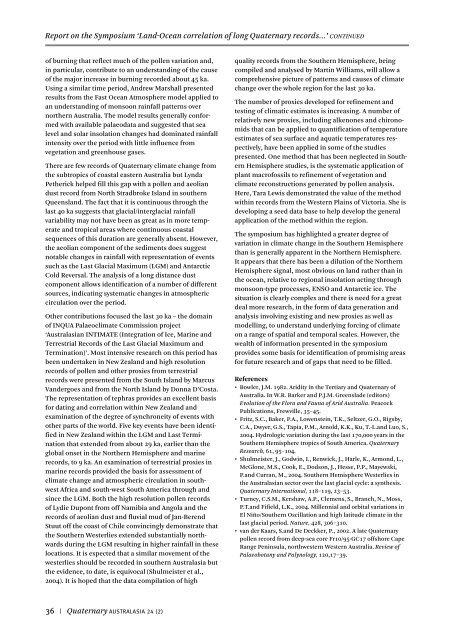QA_Vol 24_No 1_July 2007 - Australasian Quaternary Association
QA_Vol 24_No 1_July 2007 - Australasian Quaternary Association
QA_Vol 24_No 1_July 2007 - Australasian Quaternary Association
Create successful ePaper yourself
Turn your PDF publications into a flip-book with our unique Google optimized e-Paper software.
Report on the Symposium ‘Land-Ocean correlation of long <strong>Quaternary</strong> records...’ CONTINUEDof burning that reflect much of the pollen variation and,in particular, contribute to an understanding of the causeof the major increase in burning recorded about 45 ka.Using a similar time period, Andrew Marshall presentedresults from the Fast Ocean Atmosphere model applied toan understanding of monsoon rainfall patterns overnorthern Australia. The model results generally conformedwith available palaeodata and suggested that sealevel and solar insolation changes had dominated rainfallintensity over the period with little influence fromvegetation and greenhouse gases.There are few records of <strong>Quaternary</strong> climate change fromthe subtropics of coastal eastern Australia but LyndaPetherick helped fill this gap with a pollen and aeoliandust record from <strong>No</strong>rth Stradbroke Island in southernQueensland. The fact that it is continuous through thelast 40 ka suggests that glacial/interglacial rainfallvariability may not have been as great as in more temperateand tropical areas where continuous coastalsequences of this duration are generally absent. However,the aeolian component of the sediments does suggestnotable changes in rainfall with representation of eventssuch as the Last Glacial Maximum (LGM) and AntarcticCold Reversal. The analysis of a long distance dustcomponent allows identification of a number of differentsources, indicating systematic changes in atmosphericcirculation over the period.Other contributions focused the last 30 ka – the domainof INQUA Palaeoclimate Commission project‘<strong>Australasian</strong> INTIMATE (Integration of Ice, Marine andTerrestrial Records of the Last Glacial Maximum andTermination)’. Most intensive research on this period hasbeen undertaken in New Zealand and high resolutionrecords of pollen and other proxies from terrestrialrecords were presented from the South Island by MarcusVandergoes and from the <strong>No</strong>rth Island by Donna D’Costa.The representation of tephras provides an excellent basisfor dating and correlation within New Zealand andexamination of the degree of synchroneity of events withother parts of the world. Five key events have been identifiedin New Zealand within the LGM and Last Terminationthat extended from about 29 ka, earlier than theglobal onset in the <strong>No</strong>rthern Hemisphere and marinerecords, to 9 ka. An examination of terrestrial proxies inmarine records provided the basis for assessment ofclimate change and atmospheric circulation in southwestAfrica and south-west South America through andsince the LGM. Both the high resolution pollen recordsof Lydie Dupont from off Namibia and Angola and therecords of aeolian dust and fluvial mud of Jan-BerendStuut off the coast of Chile convincingly demonstrate thatthe Southern Westerlies extended substantially northwardsduring the LGM resulting in higher rainfall in theselocations. It is expected that a similar movement of thewesterlies should be recorded in southern Australasia butthe evidence, to date, is equivocal (Shulmeister et al.,2004). It is hoped that the data compilation of highquality records from the Southern Hemisphere, beingcompiled and analysed by Martin Williams, will allow acomprehensive picture of patterns and causes of climatechange over the whole region for the last 30 ka.The number of proxies developed for refinement andtesting of climatic estimates is increasing. A number ofrelatively new proxies, including alkenones and chironomidsthat can be applied to quantification of temperatureestimates of sea surface and aquatic temperatures respectively,have been applied in some of the studiespresented. One method that has been neglected in SouthernHemisphere studies, is the systematic application ofplant macrofossils to refinement of vegetation andclimate reconstructions generated by pollen analysis.Here, Tara Lewis demonstrated the value of the methodwithin records from the Western Plains of Victoria. She isdeveloping a seed data base to help develop the generalapplication of the method within the region.The symposium has highlighted a greater degree ofvariation in climate change in the Southern Hemispherethan is generally apparent in the <strong>No</strong>rthern Hemisphere.It appears that there has been a dilution of the <strong>No</strong>rthernHemisphere signal, most obvious on land rather than inthe ocean, relative to regional insolation acting throughmonsoon-type processes, ENSO and Antarctic ice. Thesituation is clearly complex and there is need for a greatdeal more research, in the form of data generation andanalysis involving existing and new proxies as well asmodelling, to understand underlying forcing of climateon a range of spatial and temporal scales. However, thewealth of information presented in the symposiumprovides some basis for identification of promising areasfor future research and of gaps that need to be filled.References• Bowler, J.M. 1982. Aridity in the Tertiary and <strong>Quaternary</strong> ofAustralia. In W.R. Barker and P.J.M. Greenslade (editors)Evolution of the Flora and Fauna of Arid Australia. PeacockPublications, Frewville, 35–45.• Fritz, S.C., Baker, P.A., Lowenstein, T.K., Seltzer, G.O., Rigsby,C.A., Dwyer, G.S., Tapia, P.M., Arnold, K.K., Ku, T.-L.and Luo, S.,2004. Hydrologic variation during the last 170,000 years in theSouthern Hemisphere tropics of South America. <strong>Quaternary</strong>Research, 61, 95–104.• Shulmeister, J., Godwin, I., Renwick, J., Harle, K., Armond, L.,McGlone, M.S., Cook, E., Dodson, J., Hesse, P.P., Mayewski,P.and Curran, M., 2004. Southern Hemisphere Westerlies inthe <strong>Australasian</strong> sector over the last glacial cycle: a synthesis.<strong>Quaternary</strong> International, 118–119, 23–53.• Turney, C.S.M., Kershaw, A.P., Clemens, S., Branch, N., Moss,P.T.and Fifield, L.K., 2004. Millennial and orbital variations inEl Niño/Southern Oscillation and high latitude climate in thelast glacial period. Nature, 428, 306–310.• van der Kaars, S.and De Deckker, P., 2002. A late <strong>Quaternary</strong>pollen record from deep-sea core Fr10/95-GC17 offshore CapeRange Peninsula, northwestern Western Australia. Review ofPalaeobotany and Palynology, 120,17–39.36 | <strong>Quaternary</strong> AUSTRALASIA <strong>24</strong> (2)


